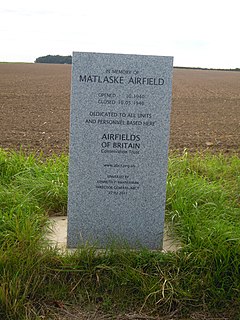
The Harrier, informally referred to as the Harrier Jump Jet, is a family of jet-powered attack aircraft capable of vertical/short takeoff and landing operations (V/STOL). Named after a bird of prey, it was originally developed by British manufacturer Hawker Siddeley in the 1960s. The Harrier emerged as the only truly successful V/STOL design of the many attempted during that era, despite being a subsonic aircraft, unlike most of its competitors. It was conceived to operate from improvised bases, such as car parks or forest clearings, without requiring large and vulnerable air bases. Later, the design was adapted for use from aircraft carriers.

Number 17 Squadron, currently No. 17 Test and Evaluation Squadron (TES), is a squadron of the Royal Air Force. It was reformed on 12 April 2013 at Edwards Air Force Base, California, as the Operational Evaluation Unit (OEU) for the Lockheed Martin F-35B Lightning.

No. 6 Squadron of the Royal Air Force operates the Eurofighter Typhoon FGR.4 at RAF Lossiemouth. It was previously equipped with the Jaguar GR.3 in the close air support and tactical reconnaissance roles, and was posted to RAF Coltishall, Norfolk until April 2006, moving to RAF Coningsby until disbanding in May 2007. The squadron officially reformed as a Typhoon squadron on 6 September 2010.

The Hawker Hart was a British two-seater biplane light bomber aircraft of the Royal Air Force (RAF). It was designed during the 1920s by Sydney Camm and manufactured by Hawker Aircraft. The Hart was a prominent British aircraft in the inter-war period, but was obsolete and already side-lined for newer monoplane aircraft designs by the start of the Second World War, playing only minor roles in the conflict before being retired.

The former Royal Air Force Station Brüggen, more commonly known as RAF Brüggen, in Germany was a major station of the Royal Air Force until 15 June 2001. It was situated next to the village of Elmpt, approximately 43 kilometres (27 mi) west of Düsseldorf near the Dutch-German border. The base was named after the village of Brüggen, the nearest rail depot. Construction began in mid-1952, which involved the clearing of forest and draining of marshland. The station became active in 1953 during the rapid expansion of NATO forces in Europe. In 2002, it was handed over to the British Army and renamed Javelin Barracks.

No. 3(F) Squadron of the Royal Air Force operates the Typhoon F2, FGR4 and T3 from RAF Coningsby, Lincolnshire. It was formed in 1912 as one of the first squadrons of the Royal Flying Corps.

1 Squadron SAAF was an air force squadron of the South African Air Force and was formed at Air Force Station Swartkop in February 1920, equipped with De Havilland DH.9's part of the Imperial Gift donation to South Africa by Britain. On 31 August 1939 the squadron was re-designated as 1 Bomber/Fighter Squadron and this was then changed to 11 (Bomber) Squadron in December 1939. The squadron was resurrected in February 1940 by the renumbering of 6 Squadron, equipped with four Hurricane Mk 1's and six Furies.

No. 33 Squadron of the Royal Air Force operates the Puma HC.2 from RAF Benson, Oxfordshire.
No. 193 Squadron RAF was a fighter squadron of the Royal Air Force during World War II.

No. 266 (Rhodesia) Squadron RAF was a squadron of the Royal Air Force.

No 501 Squadron was the fourteenth of the twenty-one flying units in the Royal Auxiliary Air Force, the volunteer reserve part of the British Royal Air Force. The squadron won seven battle honours, flying Hurricane, Spitfire and Tempest fighter aircraft during World War II, and was one of the most heavily engaged units in RAF Fighter Command. In particular, the Squadron saw extensive action during the Battle of France and Battle of Britain. At present the unit is not flying any more and has a logistics role as part of No 85 Expeditionary Logistics Wing.

RAF Westhampnett was a Royal Air Force station, located in the village of Westhampnett near Chichester, in the English County of West Sussex.

No. 112 Squadron was a squadron of the Royal Air Force. It served in both the First World War and Second World War and was active for three periods during the Cold War. It is nicknamed "The Shark Squadron", an allusion to the fact that it was the first unit from any Allied air force to use the famous "shark mouth" logo on Curtiss P-40s.

No. 79 Squadron was a squadron of the Royal Air Force.

RAF Matlaske was a satellite air field of the Royal Air Force to RAF Coltishall, situated near Matlaske in Norfolk, England.

No. 93 Squadron RAF was an aircraft squadron of the Royal Air Force during World War II. It was initially formed during World War I on 1 September 1917 but it did not become operational and was disbanded one year later in August 1918. The unit was reformed in October of the same year to be equipped with Sopwith Dolphins but was again disbanded only a month later.
No. 168 Squadron RAF was a Second World War Royal Air Force squadron that operated the North American Mustang on missions over occupied Europe and in support of the D-Day landings.
No. 137 Squadron RAF existed briefly as a day bomber unit in World War I but it never became operational. During World War II it flew as one of the two Whirlwind squadrons before converting to Hurricane Mk.IV fighter-bombers and later the Hawker Typhoon in the same role. The squadron was disbanded in August 1945.
No. 296 Squadron RAF was an airborne forces squadron of the Royal Air Force during World War II. With sister squadrons 295 and 297 it formed 38 Wing, which later expanded to create No. 38 Group RAF.
No. 98 Squadron was a Royal Air Force bomber squadron during World War I and World War II. It flew fighter-bombers post-war, and converted to fighters in 1955. Reformed as a ballistic missile unit between 1959 and 1963, its final incarnation was as a radar calibration unit. It was disbanded in 1976.
















